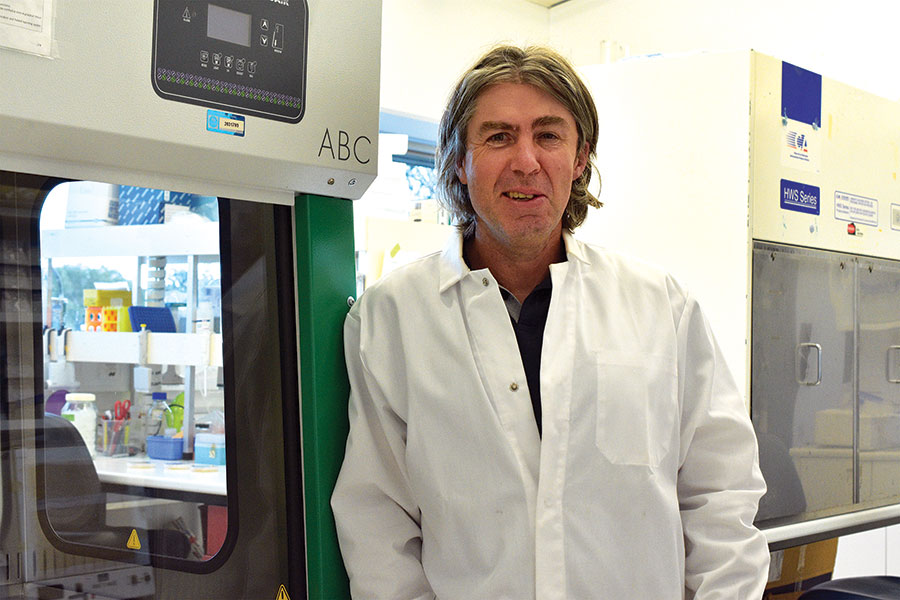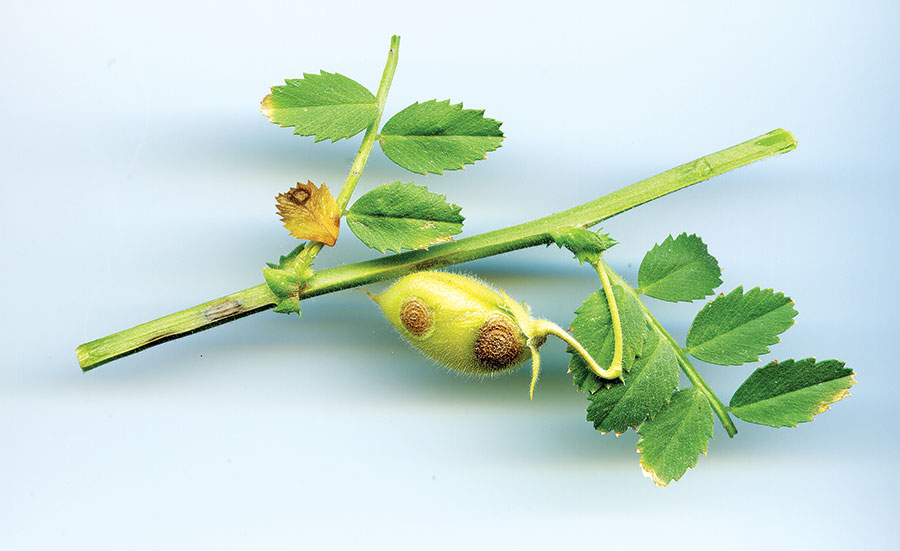Australia
October 12, 2022
.jpg)
Researcher Dr Josh Fanning explored the economics of fungicide applications for controlling Ascochyta blight of chickpeas in-season. - Photo: Agriculture Victoria
Studying the Ascochyta blight life cycle in chickpeas in the hope of better informing out-of-season integrated disease management (IDM) strategies is the focus of a GRDC investment being conducted by the CSIRO.
Ascochyta blight of chickpeas is a serious fungal disease caused by the crop-specific pathogen Phoma rabiei (formerly Ascochyta rabiei). It is most prevalent under cool, humid conditions and can infect all above-ground parts of the chickpea plant.
Sustained periods of leaf wetness encourage the spread of Ascochyta blight. In the southern growing region, even a heavy dew or fog event on a cloudy, still day can be enough to initiate a disease event during the winter growing season.
Importantly, there is no economic threshold for managing the disease. Any infection can be damaging, and most disease control strategies are focused on prevention.
CSIRO – in partnership with Agriculture Victoria, the New South Wales Department of Primary Industries (DPI) and the South Australian Department of Primary Industries and Regions’ research organisation, the South Australian Research and Development Institute – is aiming to deliver improved IDM strategies through new knowledge of disease epidemiology.
This includes novel detection of early infection, the amount of inoculum carryover required to initiate an epidemic, pathogen spread and critical timing of fungicide applications to maximise efficacy.
Phoma rabiei has demonstrated a profound ability to overcome genetic resistance bred into chickpea varieties, meaning growers need to manage and monitor their variety selection closely. Improving IDM strategies to reduce the risk of Ascochyta infection in crops will help reduce pressure on available and emerging cultivars and save growers money on fungicide sprays.
 CSIRO senior research scientist Dr Luke Barrett says improved understanding of the Ascochyta blight life cycle between growing seasons can help improve integrated disease management strategies. Photo: CSIRO
CSIRO senior research scientist Dr Luke Barrett says improved understanding of the Ascochyta blight life cycle between growing seasons can help improve integrated disease management strategies. Photo: CSIRO
CSIRO senior research scientist Dr Luke Barrett says improving IDM strategies requires a better understanding of the pathogen life cycle between seasons, to support agronomic management of inoculum.
“Nearly everything we know about Ascochyta relates to when it is a disease of the crop, so our work has been focused on understanding the off-season component of the pathogen life cycle and how we can implement IDM there,” he says.
“The critical thing is how it gets from one paddock to the next, and one crop to the next.
“We want to understand that phase of the pathogen life cycle and whether we can intervene during that phase to better manage the disease.”
Dr Barrett says understanding how long the pathogen can survive and which hosts it colonises will help growers to understand their disease risk. This knowledge will also generate off-season IDM advice based on managing susceptible crop residues, weed hosts and rotation intervals.
“We know the disease can carryover as endophytes on plant leaves or as saprophyte on other crop residues,” he says.
“As part of this project, we have detected Ascochyta living on canola leaves. In this growing season, we will be able to see how well it survived on the canola residue and whether it can infect the following chickpea crops.”
CSIRO has also cooperated with NSW DPI researchers in Tamworth, NSW, who studied in-season control of Ascochyta using fungicides. Dr Barrett’s team examined the subsequent crop residues and established that in-season disease control does not reduce post-harvest saprophytic growth in the stubble and the subsequent risk of inoculum carryover.

Ascochyta blight lesions on chickpea pods. Photo: Pulse Australia
One potential solution to this challenge could be the application of biocontrol agents to crop residues to minimise inoculum build-up.
“We have only conducted laboratory research so far, but our work is indicating that some fungi are antagonistic or able to outcompete Ascochyta in that environment,” Dr Barrett says.
Meanwhile, researchers at Agriculture Victoria’s Horsham SmartFarm have studied the economics of fungicide applications for controlling Ascochyta blight of chickpeas in-season.
Senior research scientist Dr Joshua Fanning says the primary goal has been reducing fungicide use by exploring the post-infection application of fungicides with a mixture of modes of action, including Veritas® (Group 3 and 11 mixture), Aviator® (Group 7 and 3 mixture) and Miravis® Star (Group 7 and 12 mixture).
“Growers in dry regions may avoid chickpeas in their cropping program due to low yields and the cost of several preventive fungicide sprays,” he says.
“However, post-infection spraying might reduce their fungicide requirement to one or even zero applications in low-rainfall environments, depending on whether or not infection even occurs.”
In a second set of experiments, growing chickpeas inter-row between standing cereal stubble was found to reduce disease severity and improve grain yield substantially over planting into slashed stubble.
Dr Fanning says the difference in standing stubble was equivalent to having a susceptible variety perform like a moderately susceptible variety.
“When these approaches are combined with the CSIRO’s strategies to reduce inoculum carryover and disease spread, it will be a real game-changer for chickpea growers,” he says.
The program to develop new IDM strategies is part of a national, multi-program research approach being supported by GRDC.
Due for completion in June 2024, the overall project aims to improve prevention and control of Ascochyta blight in chickpeas through new knowledge of the disease and its spread, improving genetic resistance in chickpea cultivars and developing more effective, efficient disease management strategies.
A primary goal is to reduce fungicide use for control of Ascochyta blight of chickpeas by 40 per cent.
More information: Dr Luke Barrett, 02 6246 4646, luke.barrett@csiro.au; Dr Joshua Fanning, 0419 272 075, joshua.fanning@agriculture.vic.gov.au